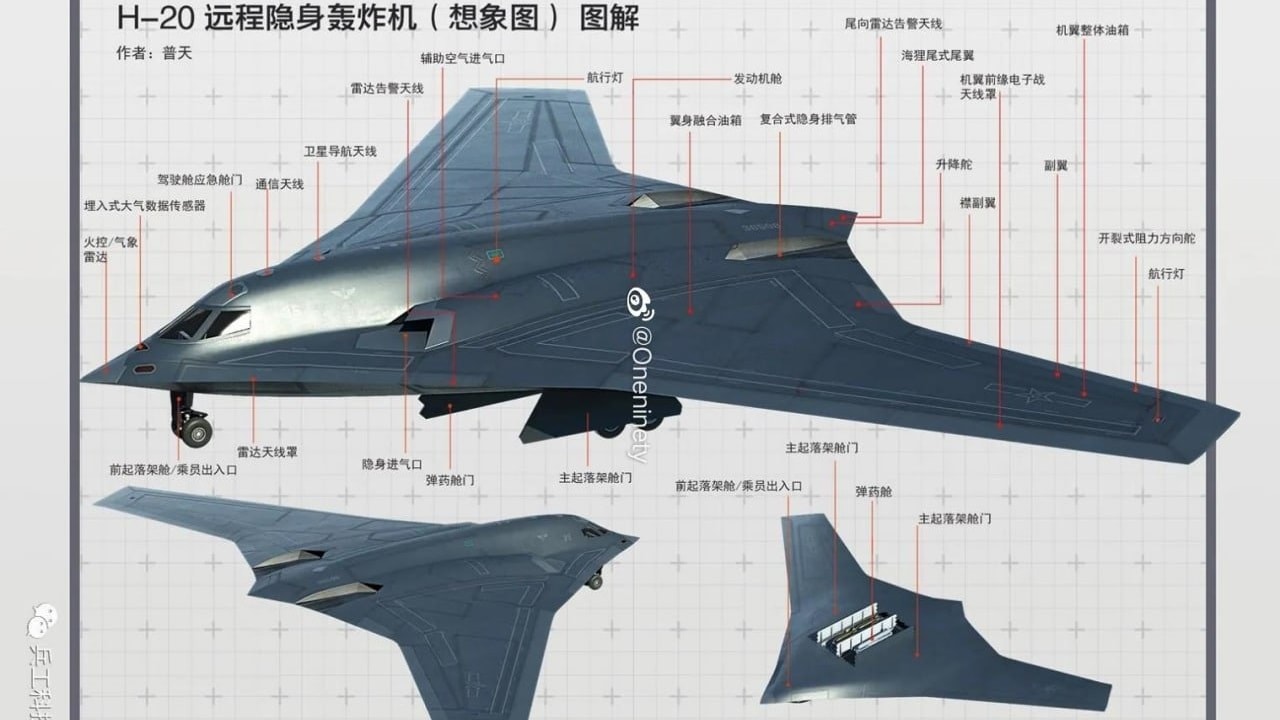
H-20: China’s New Stealth Bomber Could Have A 7,500 Mile Range
Artist Rendering of China’s H-20 Stealth Bomber. Image Credit: Chinese Internet.
Right now, only the U.S. military has stealth bombers. While the B-2 and soon-to-be-flying B-21 Raider give Washington a major advantage in any combat scenario it seem China always wants stealth bombers. Here comes the H-20: China’s H-20 strategic bomber, or sometimes called the Xian H-20, is a flying wedge type of stealth airplane that borrows its design from the American B-2 bomber. The H-20 is expected to be nuclear-capable. Its claimed range of 7,500 miles without the need for aerial refueling could threaten the United States.
This bomber would give the People’s Liberation Army Air Force, or PLAAF, a critical new component for its nuclear triad, a development that makes China more of a strategic player in great-power competition with the United States and Russia.
The H-20 Is a B-2 Clone
The Xian H-20 can be compared to the B-2, as Warrior Maven’s Kris Osborn pointed out. “It features a similar rounded upper fuselage, blended wing body, curved upper air inlets and essentially no vertical structures. There appears to be a fair amount of evidence, simply available to the naked eye, to demonstrate China’s overt ‘copycat’ maneuver,” Osborn wrote.
The new bomber would have a payload of 45 tons, meaning the H-20 could carry nuclear-armed bombs or missiles – maybe even nuclear-tipped hypersonic cruise missiles. The H-20 might also equip conventional munitions such as land-attack cruise missiles that could threaten U.S. interests in the Indo-Pacific region. It may not be until the late 2020s before the H-20 is produced in numbers, but the dual-use capability, stealth characteristics, and long range make the aircraft’s development worth tracking.
The PLAAF would not need a large fleet of H-20 bombers to make a difference in the Indo-Pacific or to target the United States with nuclear weapons. It is also developing the JH-XX fighter-bomber concept. Both aircraft could be escorted by the J-20 Mighty Dragon, a fighter with radar-evading capabilities that would enable attacks against Taiwan, Guam, and Japan.
But China also continues its push to operate beyond its neighborhood. It wants a blue-water navy with a nuclear-powered aircraft carrier. It has strategic nuclear missiles such as the DF-41 that analysts fear can reach the United States. It is developing an intercontinental submarine-launched nuclear missile called the JL-3. Now it strives to improve another leg of its nuclear triad with a nuclear-equipped strategic bomber.
H-20 – Anything But a Peaceful Rise for China
The Chinese are adept at copying American designs and then developing them over time. This ruthless approach is part of Beijing’s pursuit of global status. It wants to overawe its neighbors and make the United States take notice, especially when it comes to nuclear weapons.
It is no longer a peaceful rise for the Chinese, John A. Tirpak wrote in Air Force Magazine.
“Part of China’s intimidation campaign is the quickening pace of its development and fielding of a nuclear triad,” Tirpak wrote. “China is on track to field more than 700 nuclear warheads by 2027 and more than 1,000 by 2030, versus about 200 noted in the 2019 edition of the China Military Power Report.”
Along with the number of nuclear devices, China knows it needs a stealth delivery system for the aerial leg of the nuclear triad. Thus the H-20 will play an important role in the drive toward nuclear parity with the United States and Russia. Beijing hopes to match Moscow’s nuclear triad. It may want to force the Americans to the negotiating table and bargain for an arms treaty that could give it parity with the United States, equating to world prestige. Or, Beijing could resist negotiations and continue to build up its nuclear capabilities unabated. Either way, China’s rise is anything but peaceful – and the H-20 is part of that narrative.
Now serving as 1945’s Defense and National Security Editor, Brent M. Eastwood, PhD, is the author of Humans, Machines, and Data: Future Trends in Warfare. He is an Emerging Threats expert and former U.S. Army Infantry officer. You can follow him on Twitter @BMEastwood.
No comments:
Post a Comment